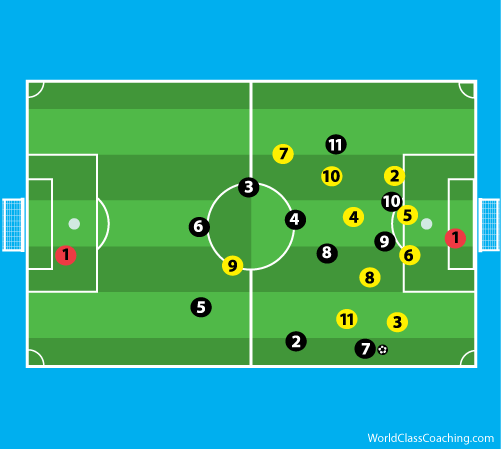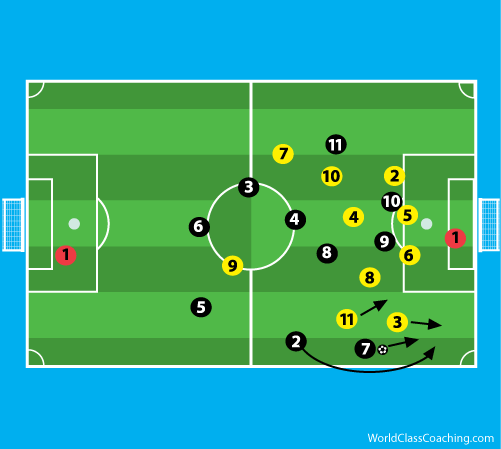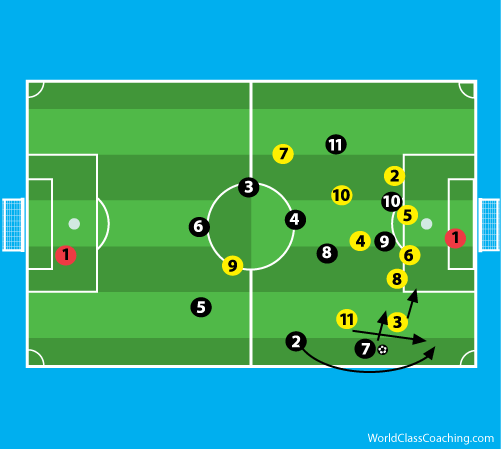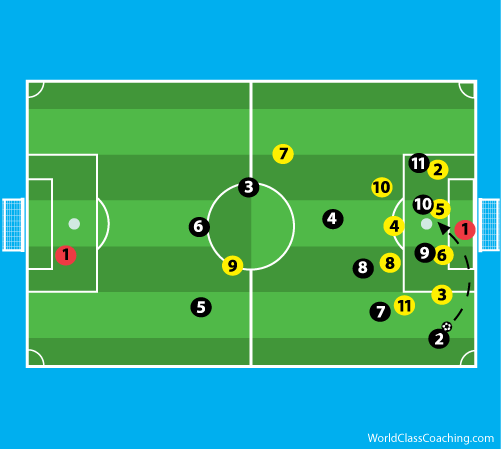My primary concern about changing to a 4-3-3 system was how to deal with players attacking from wide areas. With only three midfielders, all of whom play centrally, I was worried that this would be an area that other teams could exploit. So making sure we had a plan to deal with this problem became a primary concern.
One of the strengths of the 4-4-2 system is it's ability to create 2 v 1 situations on the wings. So if we're going to play from a 4-3-3, how will we prepare for this? David Platt deals with this question in his, 'How to Play Against and Beat the 4-4-2". Below is an excerpt from Chapter 7 of the book, Defending Against the 4-4-2 - Defensive Third.
Once the ball is in our defensive third our focus is to stop the ball from being delivered into the penalty area or allowing a shot at goal. Players must work exceptionally hard to win their 1 on 1 duels, at the same time as affording each other cover and doubling up on the man with the ball. Any slip up by the man closing the ball down could result in a goal being conceded so it is imperative that at all times there is a player helping who can immediately challenge the ball should the first marker be beaten. Here 3 is closing the ball down but is covered by 8 who can step in to challenge should 3 be beaten. 11 is also filing back to help but must be aware of the right full back (2) who is supporting the play. If we can force the opposition to play backwards here then we have done our jobs.
As we mentioned in the strengths of the 4-4-2 section of this book, the natural way the formation gets into 2v1 situations wide needs addressing and catering for. The next diagrams show an overlapping full back, in this case 2, in two different situations. The first is a basic overlap which can be catered for in the manner shown with 3 following the pass from 7 and challenging the advancing 2.
If the space is created for the overlap by 7 dribbling inside with the ball then 3 has to follow him which leaves 11 having to track all the way back with 2 to challenge. This dribbling movement inside by 7 effects the other players as shown who must start to come over to apply some cover. Allowing 7 to come inside has a greater effect on our positions than if he is shown outside so the preference would be for 2 negate this option by forcing 7 to go down the line, ie; outside.
If they do get into positions where they can cross from then this has to be dealt with. In this instance, 3 must work very hard to stop the cross, making himself as big a barrier as possible for the ball to get round. There are two trains of thoughts on marking in the penalty area, some coaches prefer to mark zones as seen here...
If they do get into positions where they can cross from then this has to be dealt with. In this instance, 3 must work very hard to stop the cross, making himself as big a barrier as possible for the ball to get round. There are two trains of thoughts on marking in the penalty area, some coaches prefer to mark zones as seen here...
As we have seen before, the 3-5-2 formation has no real changes in regard to defending in the mid third and even less so when defending in the defensive third.
Have a great day!
Tom








